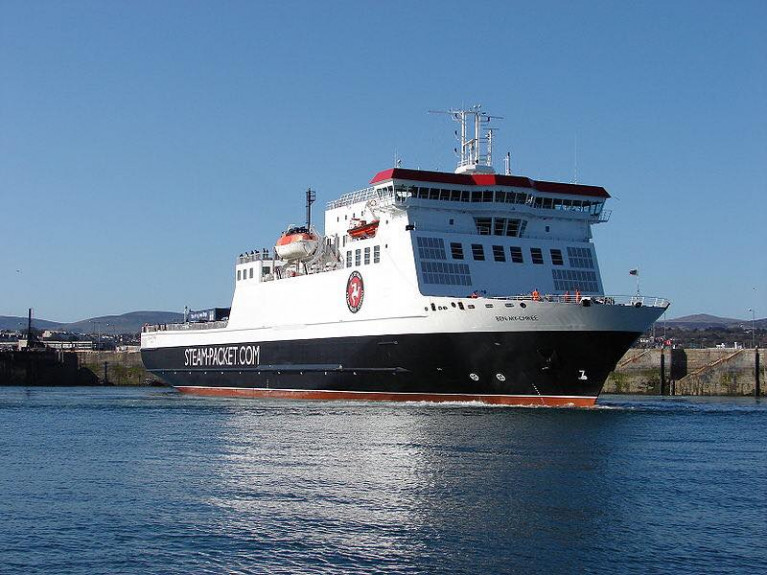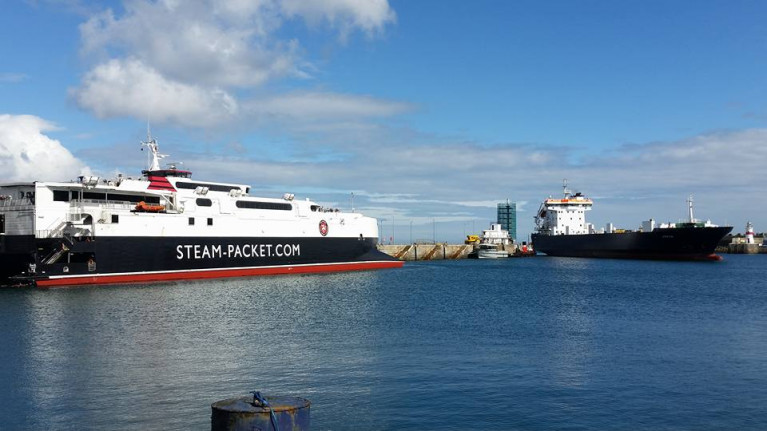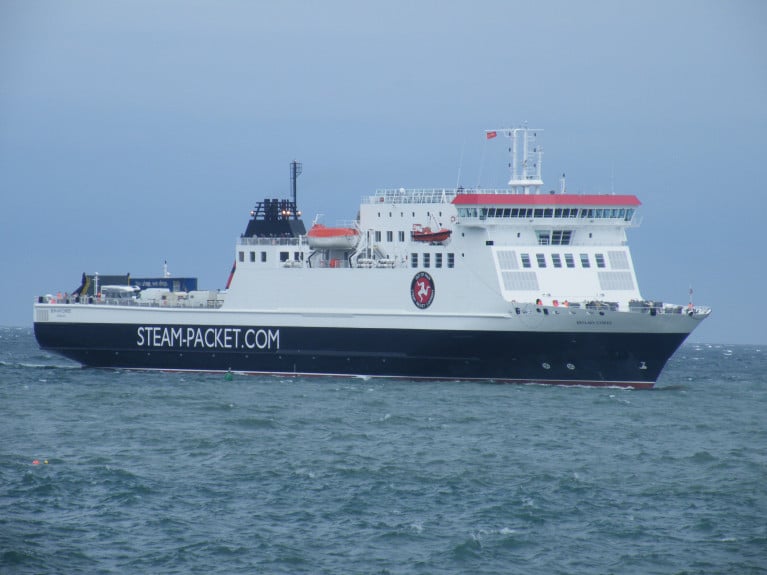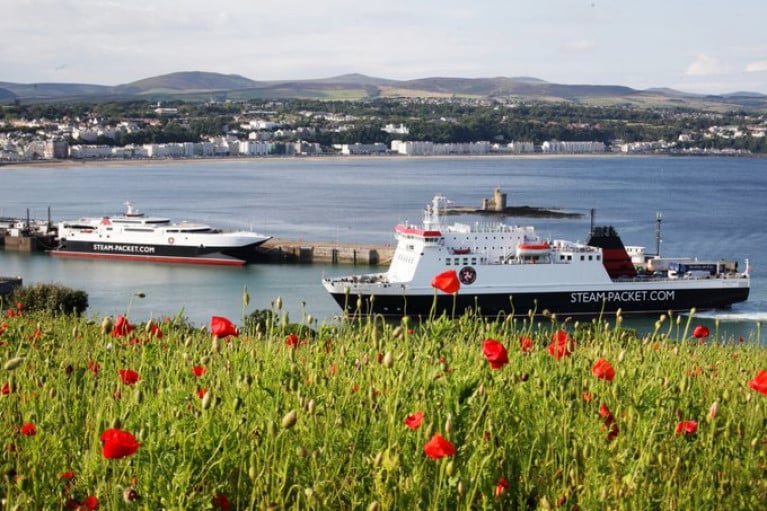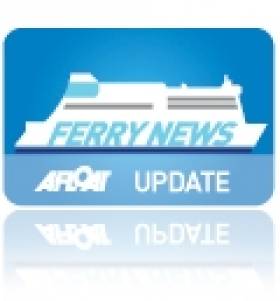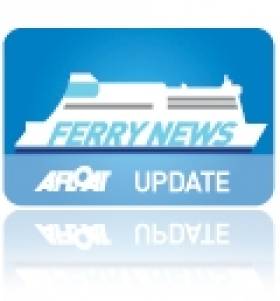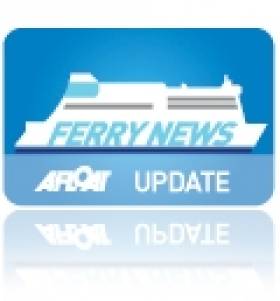Displaying items by tag: Manx Ferry
Main Isle of Man Ferry Returns to Service
The main Isle of Man ferry (has returned) to service after delays during its annual overhaul (at a Merseyside shipyard).
As BBC News reported, the Ben-my-Chree had been due to resume crossings in mid-May but was delayed after inspections found its stern tube bearings were more worn than expected.
The vessel's first passenger and freight journey will leave Douglas for Heysham, Lancashire, at 20:45 BST, the Isle of Man Steam Packet Company said.
The ferry arrived back in Douglas Harbour on Thursday evening.
A Steam Packet spokesman said both the Manannan and MV Arrow, which had been undertaking the services, would "now be rested for a few weeks".
The fastcraft would resume its services to Liverpool on 1 July "subject to borders opening", he added.
The Isle of Man Steam Packet's Ben-my-Chree will head back to the Island (today, 2 June), more than seven weeks after heading intoa dry dock for refit (at Cammell Laird shipyard on Merseyside).
The company's freight and passenger ro-pax ferry has been out of service since 13 April, and was initially expected to be back in action early last month.
However, the return was delayed after a detailed inspection identified issues with the stern tube bearings, requiring work by a specialist third-party company.
The operator had hoped the work would be completed in time for the 'Ben' to return to service at the end of May.
A spokesperson for the company has confirmed the ferry was due to leave the shipyard (today), but that has been delayed after the tug that was due to bring the vessel out of the dock broke.
More from Manx Radio including an audio link.
Afloat however adds that the main Manx ferry this morning still remains on Merseyside at the Birkenhead based shipyard.
For information on alternative fast-ferry sailing schedules visit the operator's website here.
Following repairs to a propeller of a Manx ferry, the Ben-My-Chree returned to service today plying on the main route linking the Isle of Man and the UK, writes Jehan Ashmore.
The ropax custom built in 1998 for the Isle of Man Steam Packet Co. arrived to Douglas Harbour on Sunday on completion of works at A&P Falmouth in Cornwall and successful testing of propeller and steering systems.
Ben-My-Chree re-entered the passenger and freight service of Douglas-Heysham three days ahead of schedule as the Steam-Packet already had spare propeller blades in stock.
While the Ben-My-Chree was off service the ferry firm introduced a revised timetable whereby two replacement vessels ensured duties were maintained between the Isle of Man and the Lancashire port. High-speed craft Manannan operated daily passenger ferry sailings while freighter Arrow continued to provide an essential service to the Manx capital with supplies of food and cargo against the backdrop of Covid-19.
It was during Ben-My-Chree's repositioning passage from the Isle of Man to the English south-west shipyard that drone footage captured the 22 year old ferry before arrival at the dry-dock facility.
As Afloat previously reported the IOMSPCo signed a contract for a new ferry with an Asian shipyard to replace the ageing ropax with a slightly larger ferry which is due to enter service in 2023. The new ferry is to have a higher level of onboard facilities, enhanced freight capability and be more enviromentally friendly.
According to the operator they intend to retain the 'Ben' as a reserve vessel, which is in the hands of Arrow (albeit a freight-only ro-ro ship) chartered in from Seatruck Ferries. Currently the Spanish built freighter is at anchor in Douglas Bay.
Meanwhile Manannan made manouveres in Belfast Lough this afternoon following conclusion of seasonal only routes services including Belfast Harbour but not to Dublin Port. Like all ferry operators, the key summer season was beset with Covid-19 travel restictions affecting Manx residents along with plans by holidaymakers.
Despite the troublesome season, the Isle of Man is in an extremely fortunate position of having had no active cases of Covid-19 in the Island since early June. This positive news is thanks to the remarkable efforts of the Manx people and the Isle of Man Government in addition the ability to restrict access to the island.
Access to the Isle of Man remains tightly restricted for non-residents, though according to the Steam-Packet they anticipate restrictions will be eased and look forward to welcoming visitors in 2021 when it is safe to do so noting bookings are now available through a 'Book with Confidence Commitment'. This measure is designed to provide customers with greater flexibility and peace of mind during the uncertainty caused by Covid-19.
As mentioned above Manannan's season has ceased and so the HSC will require a winter-lay-up which in recent years has taken place in Douglas Harbour where this afternoon the ferry is bound with an arrival expected to be early this evening.
Main Manx Ferry to Resume Service After Repairs to Propeller
The main Isle of Man passenger and freight ferry will return to service earlier than expected after a damaged propeller was repaired, the operator has said.
As BBC News reports, Ben-my-Chree was damaged during a crossing between Douglas and Heysham, Lancashire, on 27 August.
A spare propeller blade was readily available and meant repairs were completed "ahead of plan", the Steam Packet Company said.
Services were expected to resume on Friday but will now do so on Tuesday.
For further reading on the return of the ropax click here.
Ferry Propeller Damage Halts Isle of Man-Heysham Sailings
A ferry's propeller has been damaged, BBC News reports, which has caused disruption to sailings between the Isle of Man and Lancashire, England.
The Ben-my-Chree suffered the damage during its evening crossing from Douglas to Heysham on Thursday, the Isle of Man Steam Packet Company said.
The firm said the extent of the repairs needed was unclear and services could be affected until at least Sunday. (Afloat adds for latest sailings scheduled click here)
Passengers have been transferred to the Manannan sailings between Douglas and Liverpool.
The damage is being assessed by divers in Heysham Port.
The back-up vessel MV Arrow will be brought in to operate freight services, a company spokesman said.
Isle of Man sailings on a daily basis to and from the island will be carried out by the (fast-ferry) Manannan, while the Ben-my-Chree is out of service for two weeks.
The latest changes to the Isle of Man Steam Packet Company's schedule are a further response to the Covid-19 pandemic.
From tomorrow (yesterday) the fast craft is to carry out daytime sailings (between Douglas) and Heysham - with additional overnight freight services provided by the MV Arrow.
For more Manx Radio reports here.
Afloat adds that the radio station also reported on Tuesday of the first batch of repatriated residents that returned yesterday to the Isle of Man from Heysham.
This involved the Manannan arriving in Douglas Harbour with 29 of a total of 400 Manx residents due to sail across the Irish Sea from Britain.
#ManxFerry&Freight – Isle of Man Steam Packet ro-pax ferry Ben-My-Chree is undergoing a biannual overhaul, in her place on the Douglas-Heyham route are fast-ferry Manannan and Arrow providing freight capacity, writes Jehan Ashmore.
Work on Ben-My-Chree at Cammel Laird, Birkenhead, will include refurbishment of some of her passenger lounges, with additional seating added to the Cafe Bar. Investment to interior changes are to refresh passenger areas and improve customer experience.
The 'Ben' is scheduled for a three week dry-docking period and is expected to return to service in time for the annual TT Races starting on 24 May.
Arrow which recently began a long-term charter, has a 65-unit capacity that will provide a lifeline for the island. She represents a multi-million pound investment and effectively is an insurance policy, allowing the operator flexibility to plan for scheduled maintenance periods and if required enhanced level of backup.
The Steam Packet's Chief Executive Mark Woodward said, "It allows us to supplement Ben-my-Chree and Manannan during the TT period, and at other times of peak demand to allow extra capacity for passenger vehicles".
"Already this year, the additional freight capacity offered by MV Arrow has released space on Ben-my-Chree and helped boost TT2014 bookings, which at the end of March indicated that motorcycle bookings were up by 6% on TT2013, cars, vans and trailers were up by 5% and passengers up by 4%".
The 7,606grt Arrow which is chartered from Seatruck Ferries with an option for the Steam Packet to purchase the vessel. During periods not in use, she will go to lay-by in an Irish Sea port yet made available at short notice.
Damaged Manx Ferry Returns to Service
#ManxFerry – The main ferry serving the Isle of Man has returned to service following contact with a pier while berthing at the start of this month in Douglas Harbour.
Repairs were made to Ben-my-Chree and she has since returned to operating a normal service between the Manx capital and Heysham.
The ro-pax ferry suffered damage four metres above her waterline after colliding with a berthing fender while docking at the linkspan at berth No. 5 along the King Edward Pier.
Dublin-Douglas December Winter Sailings
#MANX FERRY- In preparation for the busy festive season, the Isle of Man Steam Packet Co. (IOMSPCo) are to deploy Ben-My-Chree to operate two round-trip Douglas-Dublin Port crossings, writes Jehan Ashmore.
The ro-pax (90-freight trailer/630 passenger) ferry is scheduled to depart Douglas on Saturday 22 December at 19.30hrs with an arrival in Dublin Port at 00.15hrs on the morning of Sunday 23 December. The return sailing departs the Irish capital at 01.00hrs.
On the following weekend, Ben-My-Chree heads for the 4 hour 45 minute Irish route again on Saturday 29 December, departing Douglas at 19.30hrs and arriving in Dublin just after mid-night at 00.15hrs. The return crossing on Sunday 30 December to the Manx capital departs 01.00hrs.
For updates on sailing schedules to include Manx-UK routes between Douglas-Heysham and the winter only operated Douglas-Liverpool (Birkenhead) route visit: www.steam-packet.com/en/LatestSailings
Plans for Wind-Farms Won’t Affect Manx Ferry Operator
#MANX FERRY – The IOM Today reports that the Manx Government is drawing up plans to ensure that any wind-farms built within the waters off the island would not affect ferry routes.
Work on the Isle of Man Marine Plan is under way and the Department of Environment, Food and Agriculture's director of environment Martin Hall said it was important it was completed in a 'timely manner'.
One of the plan's objectives would be to identify current activities in Manx waters and safeguard their ongoing use. Mapping the location of navigation corridors, important natural areas and pipelines/cables will enable the island to identify potential wind farm sites that will not adversely affect current uses of the Manx marine environment, including ferry routes and fishing.
The comments come following criticism from the Isle of Man Steam Packet Company over Centrica's plans for a wind farm in the Irish Sea, outside Manx waters. The Steam Packet says that Centrica plans to develop in the path of two routes: Douglas-Liverpool and Douglas-Heysham, in spite of complaints from the ferry operator. For much more on this story click HERE.



























